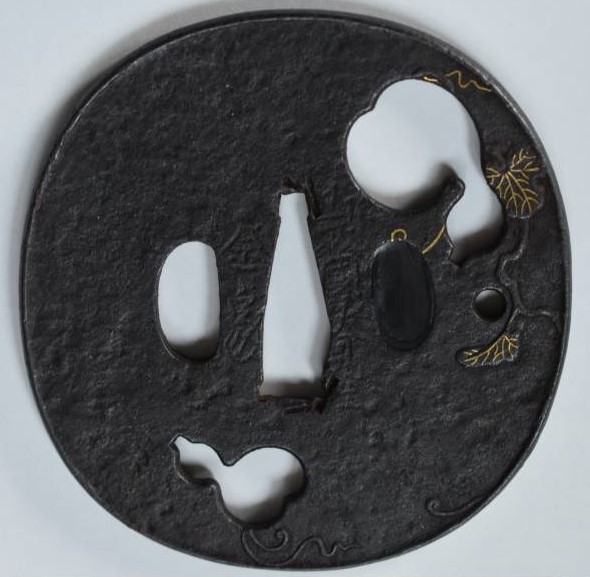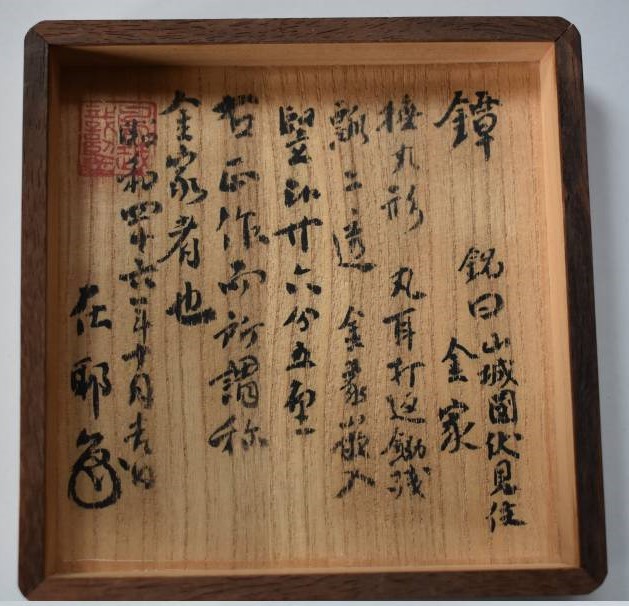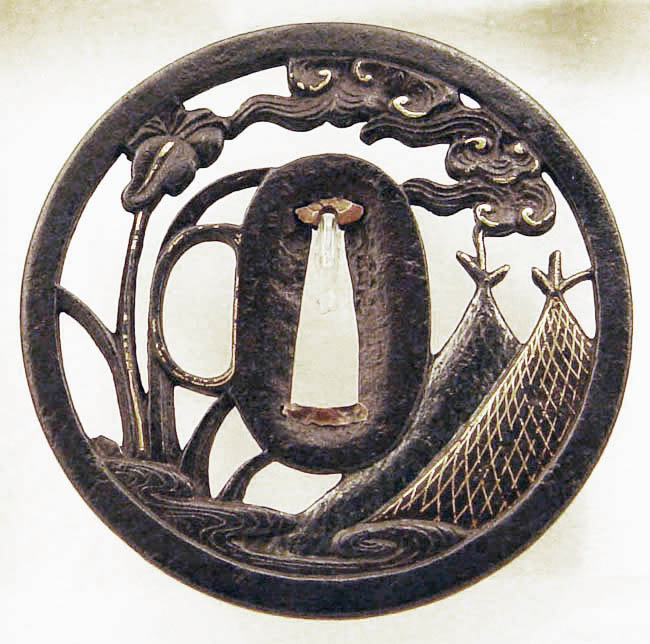THE E. D. LONG
COLLECTION
of
Dr. Kazutaro Torigoye Hakogaki Tsuba
|
KYO-SUKASHI |
| PROVENANCE: Elliott Long | |
"This guard shows much of the feeling of age of Kyo-Sukashi works. The movement in the pattern and the wide seppa-dai are important characteristics. The forms of the leaves are varied, and the metal is thick and of slightly coarse quality.The depth of the feeling of the iron suggests that this work is old even among Kyo pieces. Seems to date to Middle Muromachi period. 7.70cm x 7.70cm x 0.30cm |
|
  |
  Dr. Torigoye Hakogaki, dated 1967, 1st Class Pre-Edo period. |
|
'YAMASHIRO KUNI FUSHIMI JU KANEIYE' |
| PROVENANCE: Elliott Long | |
|
"An iron tsuba in rounded square form, with punch marks in the nakago ana. Both surfaces display a fine patina. It is provided with two kozuka ana, one being plugged with shakudo, and are original to the piece. The design is of two gourds in sukashi, the largest being among its stem with leaves in gold inlay. This same stem and leaf design appears on the reverse but across from the large gourd. This tsuba is signed: 'YAMASHIRO KUNI FUSHIMI JU KANEIYE'. H 02464.0. 8.00cm x 8.80cm x 0.50cm |
 |
 Comes with Hako-gaki by Dr. Torigoye |
 'YAMASHIRO KUNI FUSHIMI JU KANEIE' |
|
KO - TOSHO |
| PROVENANCE: Elliott Long | |
|
Very large, powerful Tosho tsuba, nicely forged and hammered with excellent patina and color. The hitsu-ana is original to the tsuba which was made prior to the Edo period. Sukashi of two interlocking rings having a Buddhist symbolism meaning Unity of Strength and Love, Mind and Body. Very important to the Samurai. 7.9cm x 7.8cm x 0.40cm |
 |
 Comes with Hako-gaki by Dr. Torigoye in 1970 on a lucky day in June |
 |
|
KAGA / HEIANJO |
| PROVENANCE: Elliott Long | |
|
|
 |
 NBTHK Hozon dated February 22, 2019. |
 |
 |
 Dr. Torigoye Hakogaki dated 1963. |
|
BIZEN SHOAMI |
| PROVENANCE: Dr. Kazutaro Torigoye Elliott D. Long |
|
|
An excellent round sukashi iron tsuba, the style being rich in its decorative quality. The design of fishing nets under flowers and clouds is naive yet very tasteful. The subject of this tsuba is applicable to the countryside, having a strong and bold quality. They are decorated with gold nunome inlay. Early Edo period. 8.0cm x 8.0cm x 0.25cm |
 |
|
Comes with Hako-gaki by Dr. Torigoye in 1964 on the 7th month, 17th day. |
 |
|
'JOSHU JU |
| PROVENANCE: Dr. Kazutaro Torigoye Robert E. Haynes Elliott D. Long |
|
|
H 01803.0 "Iron plate of a deep purple black color of great richness. The oval plate formed as 42 petals of a chrysanthemum bloom, with a leaf of the plant folded over the left and right sides. The right leaf showing the face and the left leaf showing the backside. Of katana size (see below). It is interesting to note that this tsuba is very "heavy" and dense when compared to others of its size and form. It may contain meteoric iron. It is signed on the face: 'JOSHU JU' (Hitachi Province) on the right side of the seppa-dai, and 'SAOTOME IESADA' on the left side. The kozuka ana is filled with a shakudo plug." (Haynes) |
 |
|
"There was more than one Saotome Iesada (see H 01803.0). This would seem to be the work of the "first" master of that name, ca. 1550. There is a dated example signed by Iesada of Tensho 5, August, which is 1577. This example would seem to fly in the face of what I have said for the entry of this name, as this example IS signed and certainly is of the date mentioned above. All of this adds to the revival of our research concerning this artist." (Haynes)
8.2cm x 8.2cm x 0.4cm. |
 |
 "This tsuba is contained in a box having a hako-gaki as follows: TSUBA, SIGNATURE, JOSHU JU SAOTOME IESADA, IRON PLATE, KIKU BLOOM SHAPE, MEASUREMENTS IN RIN AND BU, A TRUE WORK AS SIGNED, DATE OF SHOWA FOUR (1929), with RED SEAL AND SIGNATURE, SODO, and KAO, of a pre Edo period work. The Sodo name is very rare and seems to be one of the earliest art names used by Dr. Torigoye." (Haynes) "This tsuba was a gift to Robert Haynes from Dr. Torigoye about fifty years ago." (Long) |
 'JOSHU JU' (Hitachi Province) right side, 'SAOTOME IESADA' left side |
|
'AKASAKA YOSHISUMI SAKU' |
| PROVENANCE: Elliott Long | |
|
A round iron sukashi tsuba with eight cherry flowers in positive sukashi. All flower petals are very well carved. MEI: 'AKASAKA YOSHISUMI SAKU'. Of the Kogawa family working in Tokyo. Was a student of the second Unno Yoshimori. 6.80cm x 7.10cm x 0.50cm |
 |
 Comes with Hako-gaki by Dr. Torigoye in 1957 |
 |
|
'IWAI YOSHIMICHI' |
| PROVENANCE: Elliott Long | |
|
Well hammered iron plate in 'nade mokko gata' shape. Nobuiye and other early tsuba makers used this shape which, when mounted on a sword, is even more striking in appearance than as a separate piece. Its gentle curved shape has a feminine quality, reminding some of 'otafuku' or of 'okame' shapes and such were consequently called by these terms. This shape was also called 'tate mokkogata' and 'nade mokkogata' in Edo. The raised rim was formed by being beaten from both the outer circumference inward, and from the inside of the rim flange outward, known as 'uchikaeshi mimi'. Mei: 'IWAI YOSHIMICHI' H 11831.0. Made in the style of Nobuiye (H 07061.0) about ca. 1800. Art name Seiryusai. Worked primarely in Edo. 8.60cm x 9.10cm x 0.25cm (seppa) |
 |
 Comes with Hako-gaki by Dr. Torigoye |
 |
|
'UMETADA' |
| PROVENANCE: Elliott Long | |
|
Write up coming soon. Very early signature of 'UMETADA'. |
 |
 Comes with Hako-gaki by Dr. Torigoye in 1965 |
 |
|
'UMETADA TACHIBANA SHIGEYOSHI' |
| PROVENANCE: Elliott Long | |
|
A maru gata iron sukashi guard of five kiku flowers that are very well carved. Appearing on the rim is a scroll design done in very fine gold nunome. MEI: 'UMETADA TACHIBANA SHIGEYOSHI'. This was the Shigeyoshi who was said to have taken the Umetada school from Kyoto to Edo. 7.70cm x 7.80cm x 0.40cm |
 |
 Comes with Hako-gaki by Dr. Torigoye in 1956 |
 |
|
'TADATSUGU' |
| PROVENANCE: Mr. Matsuo (former student of Dr. Torigoye) Elliott D. Long |
|
|
Iron plate in marugata shape, one hitsu-ana in suhama-gata filled with lead with sekigane. The sukashi design in positive silhouette of Daruma 'sitting in front of a wall'. The meaning of the upper left kanji is 'faith' (men) and the lower left kanji is 'wall' (heki). This depicts the Daruma as he sat silently wasting away in meditation. Signed: 'TADATSUGU'. H 09190.0. The delicate subject, careful finish and refined iron establishes this tsuba as a work of perfection. 7.86cm x 7.80cm x 0.44cm |
 |
 Comes with Hako-gaki by Dr. Torigoye in 1973 |
 |
|
'TENKA CHUKO KAISAN SHOAMI JIROHACHI' |
| PROVENANCE: Robert E. Haynes | |
|
Write-up to follow. |
 |
 Comes with Hako-gaki by Dr. Torigoye |
 |
|
KANAYAMA |
| PROVENANCE: Elliott D. Long | |
|
"The iron bones of the edge are strong and natural. The surface is glossy black soft steel. The smooth surface is due to the high heat used in the forging. The quality of the iron is excellent. The shape is known as yatsu mokkogata (eight lobe shape). The design as ji-sukashi, is naive in a simple naturalistic style. Dates to Momoyama period." 7.20cm x 7.10cm x 0.44cm (edge) to 0.52cm (seppa) |
 |
 Comes with Hako-gaki by Dr. Torigoye |
 |
|
SAOTOME KO SAKU |
|
EDA KIKU ZU |
| PROVENANCE: Elliott D. Long | |
|
"chrysanthemum-shaped iron plate, 8-lobe design, both hitsu-ana original and plugged with shakudo, Heianjo kiku flower, " 7.70cm x 7.20cm x 0.30cm |
 |
 Comes with Hako-gaki by Dr. Torigoye |
 |
|
KAMAKURA |
| PROVENANCE: Elliott D. Long | |
|
"A thin iron plate with a low relief carving of warabi-te design. Kamakura tsuba were made from Late Muromachi to Edo period. They are usually thin iron ita-tsuba with uchikaeshi-mimi and mostly large dimensioned carvings. They bear similarities to Katchushi tsuba and Onin-tsuba. All of them are unsigned so there is no information about their makers; from an overall interpretation, it seems likely that they were made by craftsmen from the Katchushi group. They were quite popular. The name “Kamakura tsuba” derives from a type of engraving called Kamakura-bori (Kamakura carving), a Chinese engraving technique originally used on lacquerware, that by Muromachi period was being applied also to tea utensils, Zen-related implements and eventually to tsuba decorations. There exist both large and small examples of Kamakura tsuba: most of them are in round shape, but there are also examples in irregular kawari-gata or lobed-shape as seen here. In most cases the iron is not high quality (even though there are exceptions), they are thin ita tsuba with large-dimensioned pattern carved out in sukidashibori, often accentuated with kebori and the carvings are not very crisp. The seppadai is in almost all cases left raised in sukinokoshi manner, so is the rest of the motif, and thus it has the same height as the patterns. The rim area is slightly thinner than the seppadai and most Kamakura tsuba show a kaku-mimi ko niku in a raised sukinokoshi interpretation. They can come with or without hitsu-ana, one being subsequently opened here. The warabi-te design is a style of ornamentation which features a curved design based on curling bracken shoots." 8.30cm x 8.24cm x 0.27cm |
 |
 Comes with NBTHK Tokubetsu Hozon. |
 |
|
KAMAKURA-BORI |
| PROVENANCE: Elliott D. Long | |
|
"A thin iron plate with a low relief carving of warabi-te design. Kamakura tsuba were made from Late Muromachi to Edo period. They are usually thin iron ita-tsuba with uchikaeshi-mimi and mostly large dimensioned carvings. They bear similarities to Katchushi tsuba and Onin-tsuba. All of them are unsigned so there is no information about their makers; from an overall interpretation, it seems likely that they were made by craftsmen from the Katchushi group. They were quite popular. The name “Kamakura tsuba” derives from a type of engraving called Kamakura-bori (Kamakura carving), a Chinese engraving technique originally used on lacquerware, that by Muromachi period was being applied also to tea utensils, Zen-related implements and eventually to tsuba decorations. There exist both large and small examples of Kamakura tsuba: most of them are in round shape, but there are also examples in irregular kawari-gata or lobed-shape as seen here. In most cases the iron is not high quality (even though there are exceptions), they are thin ita tsuba with large-dimensioned pattern carved out in sukidashibori, often accentuated with kebori and the carvings are not very crisp. The seppadai is in almost all cases left raised in sukinokoshi manner, so is the rest of the motif, and thus it has the same height as the patterns. The rim area is slightly thinner than the seppadai and most Kamakura tsuba show a kaku-mimi ko niku in a raised sukinokoshi interpretation. They can come with or without hitsu-ana, one being subsequently opened here. The warabi-te design is a style of ornamentation which features a curved design based on curling bracken shoots." 8.30cm x 8.24cm x 0.27cm |
 |
 Comes with Hako-gaki by Dr. Torigoye |
 |
|
YAMAGANE MON TSUBA |
| PROVENANCE: Robert E. Haynes | |
|
Write-up to follow. |
 |
 Comes with Hako-gaki by Dr. Torigoye |
 |
|
KYO - SUKASHI |
| PROVENANCE: Robert E. Haynes | |
Iron Kyo-Sukashi tsuba with Dr. Toregoye Hakogaki, Edo period, Second class. Write-up to follow.  |
  |
Kyo-Sukashi iron tsuba with Dr. Toregoye Hakogaki, Pre-Edo, First Class.  |
  |
|
PLEASE CONTACT ME FOR A PERSONAL AND CONFIDENTIAL INQUIRY AND/OR ACQUISITION. |
GO TO TSUBA COLLECTIVE
HOME PAGE
E-MAIL Elliott at elliott@shibuiswords.com


